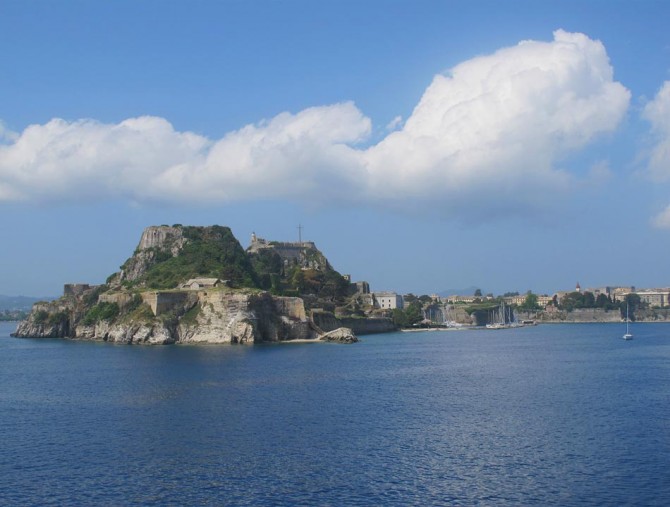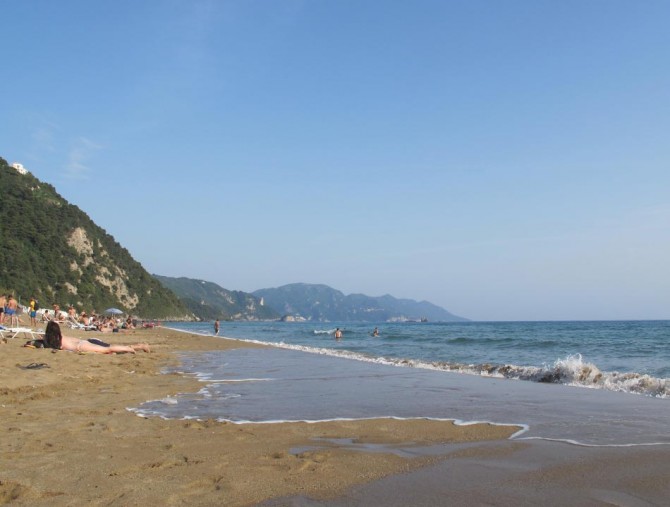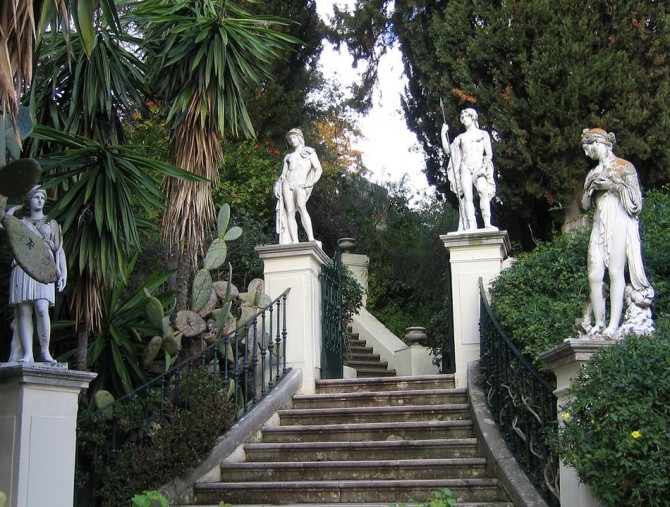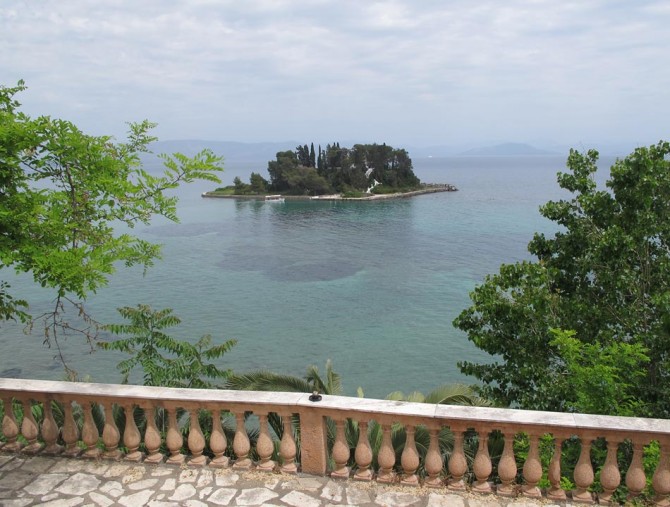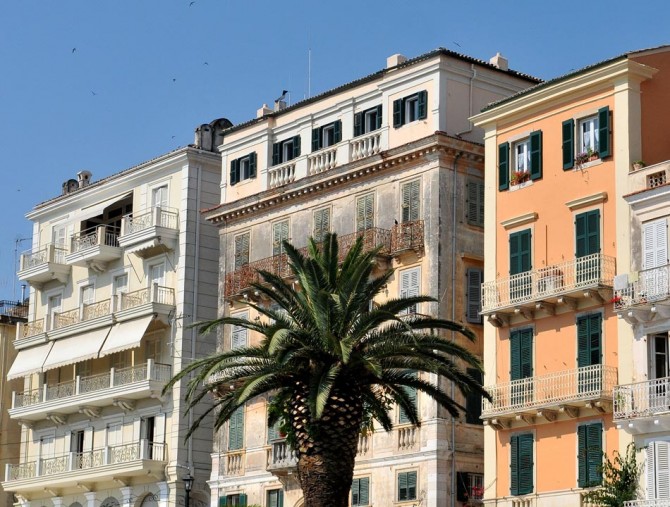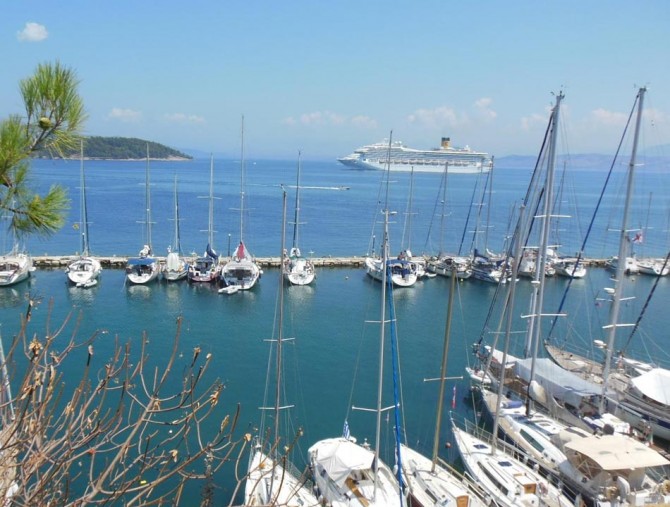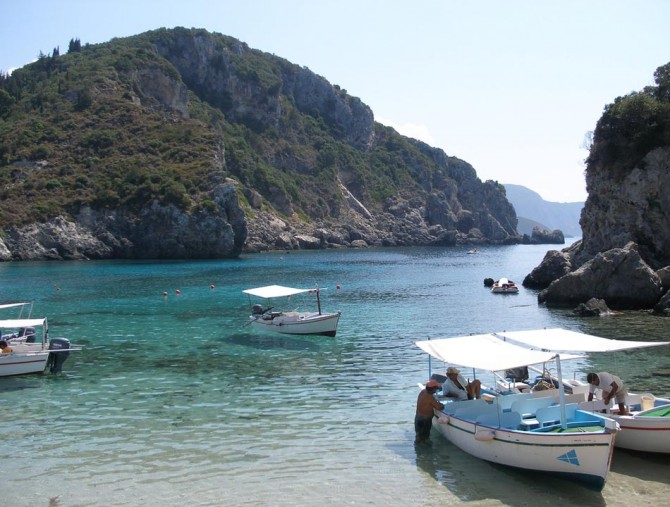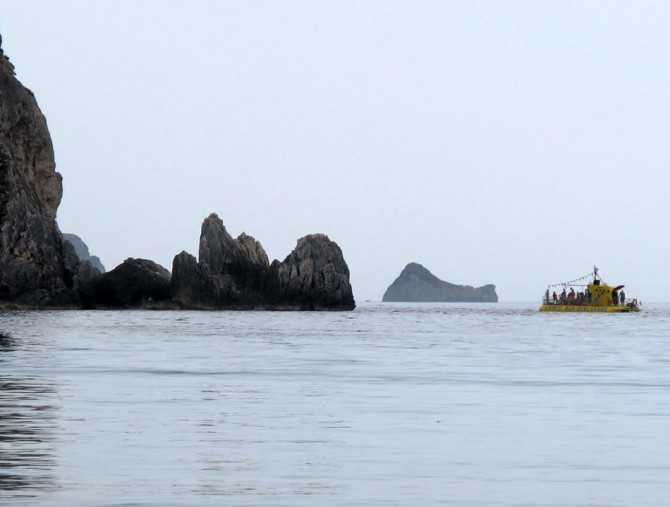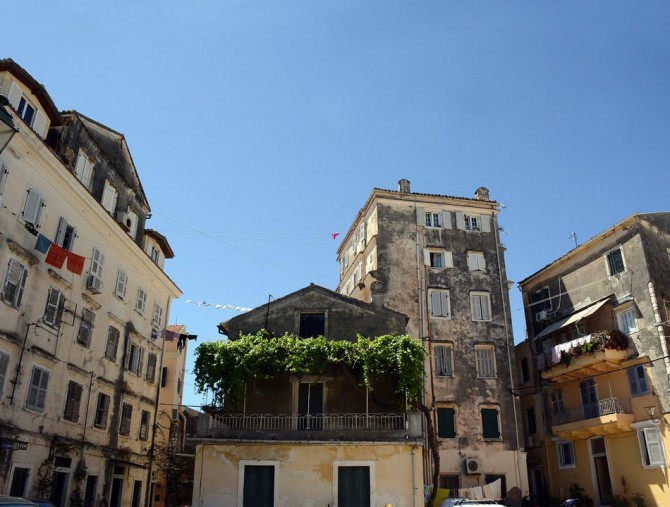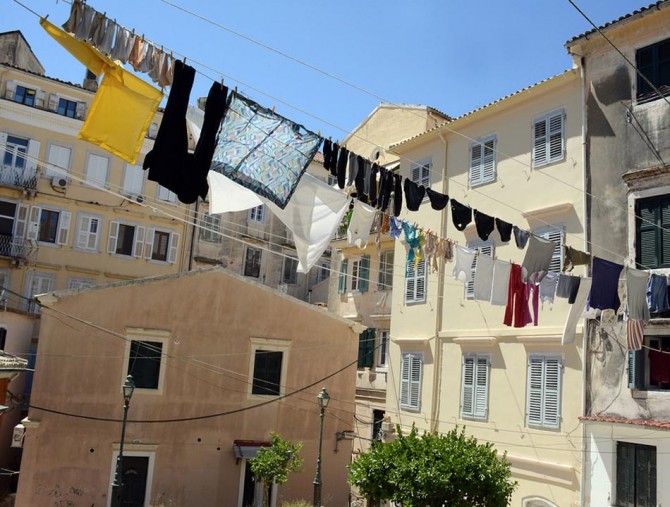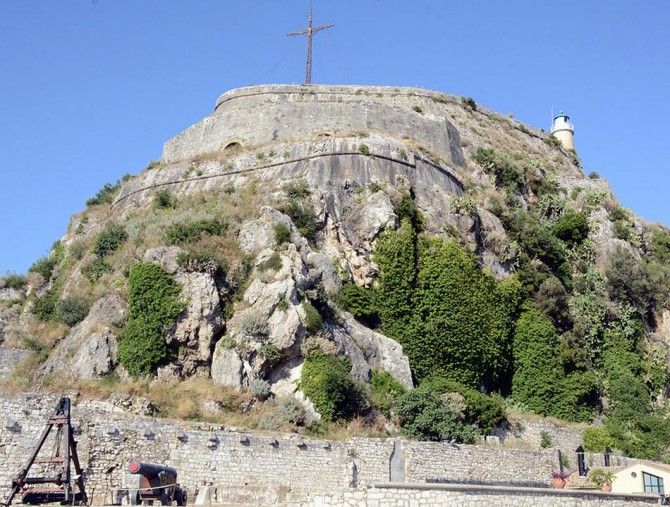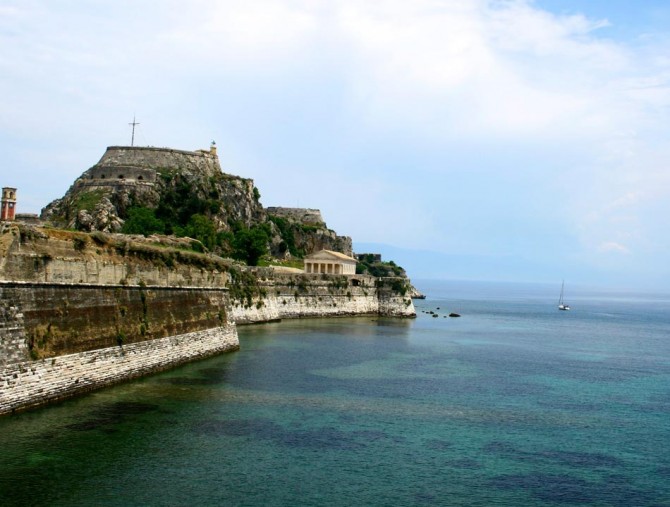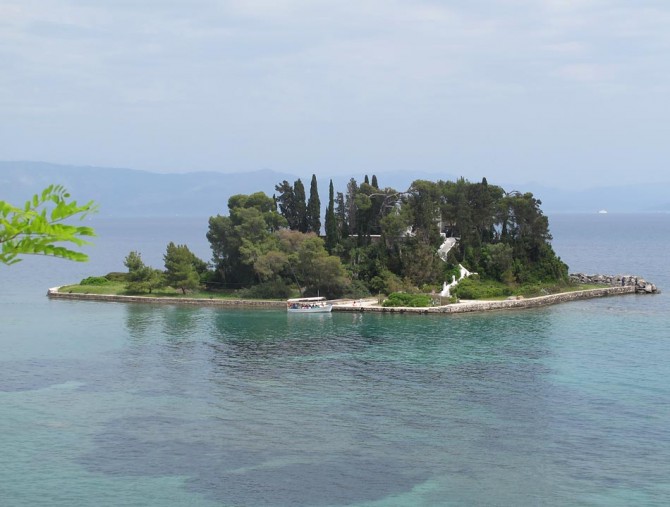Корфу (Керкира)
Греческое название Керкира или Коркира связано с двумя значительными водными символами: Посейдоном, богом моря, и Асопом, греческим божеством и крупной рекой на материковой части Греции в Беотии. В мифе Посейдон влюбился в Керкиру, дочь Асопа и речной нимфы Метопы, и украл её, что было традиционно для мифов той эпохи. Посейдон привёз Керкиру на до того неизвестный остров и, будучи безумно влюблённым, предложил её имя Коркира в качестве названия острова, которое постепенно превратилось в Керкира . Здесь у них родился ребёнок, которого назвали Феак, в честь чего население острова стали называть Феаками. Название Корфу произошло из итальянского изменённое от византийского Κορυφώ (Корифо), означающее “город гор”, произошедшее, в свою очередь от греческого Κορυφαί (Корифай) (гребень горы), подразумевающей два пика Палайо Фрорио
Корфу известен также как один из немногих островов в Греции, который никогда не был оккупирован турками. Островом владели поочередно венецианцы, французы и англичяне. Следы их пребывания заметны здесь до сих пор. Тут немало замков и зданий вполне европейского стиля. Столица острова и порт так и называется - Корфу. Как раз здесь наибольшая концентрация прекрасных строений, тенистые скверы и меленькие живописные улочки. Наиболее заметно в городе венецианское влияние. Многие семьи, говорившие по-венециански, всё время селились на Корфу, и до второй половины XX века венецианский язык звучал на его улицах. За это время местный итало-румейский греческий усвоил огромное количество итальянских и венецианских слов, которые и сегодня активно используются.
Венецианские правители проводили мягкую политику по отношению к местным феодалам, которые приняли некоторые венецианские обычаи. Корфиотам позволялось обогащаться, выращивая оливы, но запрещалось вступать в торговую конкуренцию с Венецией. Остров служил убежищем для греческих учёных и в 1732 году на острове была основана первая академия в современной Греции.
Венецианское влияние помогло и развитию оперы. Во время венецианского правления в корфиотах развилась горячая любовь к итальянской опере, которая стала двигателем экстраординарного музыкального развития острова в этот период. Именно в это время здесь появилась первая Опера в Греции.
Остров очень живописен и, за исключением южной части, весьма плодороден. Главные производимые продукты - оливковое масло, южные фрукты и вино. По всему острову проложены относительно хорошие дороги.
На Корфу сохранилось несколько исторических мест. Место древнего города Коркира (Керкира) точно установлено и находится в 2 км на юго-восток от современного города на узком куске земли между солёным озером Халикиопуло и заливом Кастрадес, в каждом из которых был порт. Под холмом Аценсион сохранился храм, обычно называемый храмом Посейдона. От Кассиопеи, единственного важного древнего города помимо столицы, имя до сих пор сохранилось в современной деревне Кассиопии, где можно найти развалины старинных зданий. На острове находится множество монастырей и других строений времен венецианского правления, самыми известными из которых являются Палеокастрицы, Сан Сальвадор и Пелека. Многочисленных туристов привлекает “Ахиллеон” — дворец, построенный Елизаветой Баварской и купленный Вильгельмом II в 1907 году.
Среди музеев столицы можно выделить Археологический музей (ул. Браила, 1), где собраны артефакты со всего острова, Азиатский музей, где можно увидеть коллекции китайского, японского и индийского искусств, и Византийский музей. В последнем представлено порядка 90 уникальных икон периода XV-XIV веков. Он расположен в красивом храме Панагия Антивунитиса по адресу: ул. Арсениу\Мурагия, чаты работы 8:00-16:00. Еще один музей Корфу посвящен первому президенту Греции Иоанну Каподистрии (ул. Каподистрии, 120). Тут, в доме этого выдающегося человека, можно увидеть артефакты, связанные с его жизнью. Поэт Дионисий Соломос также жил на Корфу и тут есть его музей (ул. Арсениу, 1).
В 3 километрах от столицы Корфу находится дворец Морепо. Это трехэтажное величественное здание было построено в 1828-1831 годах как особняк тогдашнего губернатора Корфу - сэра Фредерика Адамса. Дворец по всему периметру окружен прекрасными садами. Впоследствии, начиная с 1834 года здание использовалось как Школа изящных искусств. Начиная с 1864 года, после вхождения Корфу в состав Греции дворец использовался как королевская резиденция. В наши дни тут находится археологический музей Палеополис, где представлены артефакты относящиеся к истории Корфу начиная с VIII века до н.э.. Часы работы музея: 8:00-16:00, цена билета: 3 евро.
Считается, что лучшие пляжи Корфу находятся на полуострове Канони к югу от столицы Корфу. Еще тут есть монастырь Влахерна, который был построен в XVII веке, но главная достопримечательность всего Корфу - его товарный знак - это крошечный островок Понтикониси, который располагается рядом с Корони. Считается, что этот маленький остров был когда-то кораблем Улисса, который Посейдон превратил в зеленую скалу. Единственное здание на этом острове-скале - небольшая часовня Пантократор, которая была построена в XI веке. Посетить Понтикониси можно на лодках, которые отправляются от монастыря летом. Цена билета: 2 евро.
Канал де Амур - это один из лучших пляжей Корфу. Он находится в 32 километрах к западу от города Корфу. Здесь помимо песчаных пляжей можно увидеть немало маленьких бухт и пещер с теплыми водами. Здесь же находится знаменитый подземный канал Де Амур, который проходит через скалу. Считается, что если проплыть по нему, то найдете свою любовь на другом конце.
Агиос Георгиос считается одним из красивейших пляжей Средиземноморья. Тут есть немало “потайных” уголков для тех, кто хочет уединиться. Вода тут относительно холодная. Пляж находится в 30 километрах к северо-западу от города Корфу.
Самый космополитичный пляж Корфу называется Глифада. Он расположен в западной стороне острова. Палайокастрица - это группа из шести пляжей, которые считаются самыми популярными на острове. Также поппулярен пляж Бенитсес.
На острове довольно развита ночная жизнь, а главным местным блюдом считается - Софрито. Это говяжье филе, приготовленное с вином и уксусом.
Как добраться до Корфу:
- на пароме из Игуменицы (1 час, 45 мин.)
- на машине из Афин через порт Игуменицы (444 км) по трассе E65
- на автобусе до Игуменицы, далее на пароме до Корфу (прямой рейс) с автовокзала Кифисью, тел. станции Корфу: +30 26610 28 928
- на самолете, тел. аэропорта “Иоанн Каподистрия”: +30 26610 89 600
Tекст: Александр Фролов
Corfu
One of the most beautiful islands of Greece, by far. The queen island of the Ionian Sea. The last stop of the Ulysses’ adventurous trip, before he reaches Ithaca, according to Homer. Rich history, uncountable beauties, stately architecture, wonderful palaces and mansions, fabulous beaches and hospitable people who speak like they sing. For all these reasons and many more, Corfu is one of the most desirable touristic destinations.
According to mythology, Corfu was a nymph, daughter of Asopos, the God of the namesake river in Boeotia. Zeus fall in love with her and brought her to this island. Their son was Feakes. That is how this island was named Corfu and is also known as the Island of Feakes. With this second name it was also known in the Homeric epics. The princess of the island of Feakes, Nausica, had helped Ulysses to go back to his Ithaca, giving a happy end to his ten-year struggle to return home after the Trojan War (the story of “Odyssey”).
The island of Corfu is among the very few places in Greece that had never been occupied by the Turks. Venetians, French and English have conquered it at times, leaving behind their traces: Imposing castles and amazing buildings of European architecture. Capital city and port of Corfu is the namesake town. A magical town to be exact. The Old Town of Corfu reminds us the grandeur of previous times. Wonderful mansions, shady squares and narrow picturesque streets, which the locals call “kantounia”. The modern town, however, is equally beautiful. After you walk to the beautiful “kantounia” and admire all these wonderful buildings, you can also start your “cultural” walks.
The Archaeological Museum of Corfu houses archaeological findings from the whole island (1 Braila street, Corfu). The Museum of Asian Art of Corfu, the only museum in Greece dedicated to the art of Asia, presents collections of Chinese, Japanese, Indian and other arts(Old Palaces, Corfu, visiting hours: 8:00-20:00). The Byzantine Museum of Antivouniotissa is housed in the wonderful church of Panagia Antivouniotissa, one of the oldest churches of the island, probably built in the 15th century AD. The permanent collection includes 90 religious icons, dated from the second half of the 15th to 19th century (Arseniou street, Mouragia, Corfu. Visiting hours: 8:00-16:00. Closed on Mondays. Ticket price: 4 euros. Valid for the Archaeological Museum of Corfu, the Byzantine Museum of Antivouniotissa, the Museum of Asian Art of Corfu and the Old Fortress of Corfu).
To the east of the Old Town, the first fortress of Corfu rises, known as the Old Fortress or Fortezza, an architectural masterpiece of fortification of Byzantine and Venetian art. The gate of the Fortress is just in front of the legendary Liston, in Spianada Square, the most famous and popular spot of the town of Corfu. You must walk through the bridge over the artificial ditch, known as Contra Fossa, which has turned the Old Fortress into an island (wow!).
The Kapodistrias Museum houses objects belonging to Ioannis Kapodistrias (the first Governor of the liberated Greece), as well as period furniture in use during his lifetime (120 Kapodistriou Street, Europouloi, Corfu. Visiting hours: 8:30-15:00). The Museum of Dionysios Solomos also worth a visit. Dionysios Solomos was a great Greek poet, born in Zante, but he lived many years in Corfu. He had written the poem “Hymn to Liberty”, of which the first two stanzas, set to music by Nikolaos Mantzaros, is the Greek national anthem since 1865. The museum, which used to be the house of Solomos, exposes the poet’s desk and a small autograph, and also photographic material, referring to the sites, persons and events related to the life, work and the time of Solomos (1 Arseniou street, Corfu).
Just 3 km from the city of Corfu, a fabulous palace will open its gates for you. The Mon Repos palace is a three-storey luxury building, surrounded by wonderful gardens, built in 1828-1831, as the mansion of the English Governor of Corfu, Sir Frederic Adams. In the later years it was used as School of Fine Arts (1834), as the house of the Holy Studying (1840-1842) and as summer house of the Empress of Austria, Elisabeth (1863). In 1864, when the Ionian Islands were annexed to Greece, the palace was given to the Greek king George A’ and had been used as the summer royal residency until 1967. Since 1991, the estate and the edifice belongs to the municipality of Corfu. Today, this historical palace operates as the Archaeological Museum of Palaepolis. In the 9 luxurious halls of the palace that are open for the public, apart from the extraordinary furniture and artworks of the building itself, you can also see exhibits from all the centuries of life of the
ancient city of Corfu (late 8th c. BC to 500 AD). (Mon Repos, Corfu. Visiting hours: 8:00-16.00. Closed on Mondays. Ticket price: 3 euros).
One of the most beautiful places of the island is Kanoni, located on the namesake peninsula, in the south of the city of Corfu. This amazing place is blessed with fabulous beaches (with crystal clear and almost frozen waters) and lush vegetation. A raised strip of land connects Kanoni to the islet with the monastery of Vlacherna, built in the 17th century. But the most beautiful sightseeing of Corfu, the trademark of the island, lies just a breath away from Kanoni, in the middle of the sea. It is a tiny overgrown rocky islet, called Pontikonisi. The legend has it that this tiny islet was the Ulysses’ ship, which Poseidon turned into this green rock during a storm. The only building of Pontikonisi, hidden behind a cluster of pines and firs, is the chapel of Pantokratoras, a remarkable Byzantine church of the 11th or 12th century. You can visit Pontikonisi daily by caiques from the islet of the monastery of Vlacherna, the Easter and the whole summer
season (2 euros per person).
The beaches of Corfu are beyond any description: Golden sand, trees that extend their shadow up to water and deep blue crystal clear waters. Most of them belong to seaside settlements where you can find plenty of accommodations, restaurants and beach bars. We will just name a few of the many.
Canal d’ Amour: On the left end of the beach of Sidari, 32 km west of the city of Corfu, you will see a spot full of beautiful small coves and caves with warm waters that invite you to swim. On the far left you will find the famous Canal D`Amour, a tunnel through the rock. According to the legend, if you swim in it, you will find the love of your life in the other side.
Agios Georgios: One of the most beautiful beaches of the Mediterranean Sea. Imagine a large horseshoe of sand, enclosed on both sides by rocky formations and secret lonely beaches for romantic couples. The waters are crystal clear and rather cold. 30 km northwest from the town of Corfu.
Glyfada: Vast sandy beach, adorned with impressive rocks and trees, super organized, is one of the most cosmopolitan and popular beaches of the island, at the west side of Corfu.
Palaiokastritsa: 6 beautiful beaches, with sand or pebbles, surrounded by olive trees and spectacular vegetation, and clear crystal, rather frozen, waters. Just for the record, Palaiokastritsa is the most popular resort of Corfu.
Benitses: Also famous beach, at the south of the town of Corfu, cosmopolitan, with a combination of sand and pebbles, emerald waters and a majestic landscape, full of olive trees and lush vegetation.
In Corfu you will not have a dull moment, that is for sure. The island is very cosmopolitan and can offer you every kind of entertainment, day and night. As for the local cuisine, it is excellent, with best specialty the Sofrito, delicious beef fillets cooked with wine and vinegar. You will enjoy it more though, if you accompany it with the sounds of the notorious Corfiot serenades, another trademark of the island.
How to get there: By ferry boat from Igoumenitsa. Average travel time: 1 hour and 45 minutes. By car from Athens to Igoumenitsa and then by ferry boat to Corfu (distance 444 km), via E65. By bus from Athens (to Igoumenitsa and then by ferry boat to Corfu): Athens bus station (100 Kifissou Avenue, Athens), tel.: +30 210 51 29 443. Corfu bus station, tel.: +30 26610 28 928. By air: Corfu International Airport “Ioannis Kapodistrias”, tel.:+30 26610 89 600.
Τext: Marilou Pantazi

